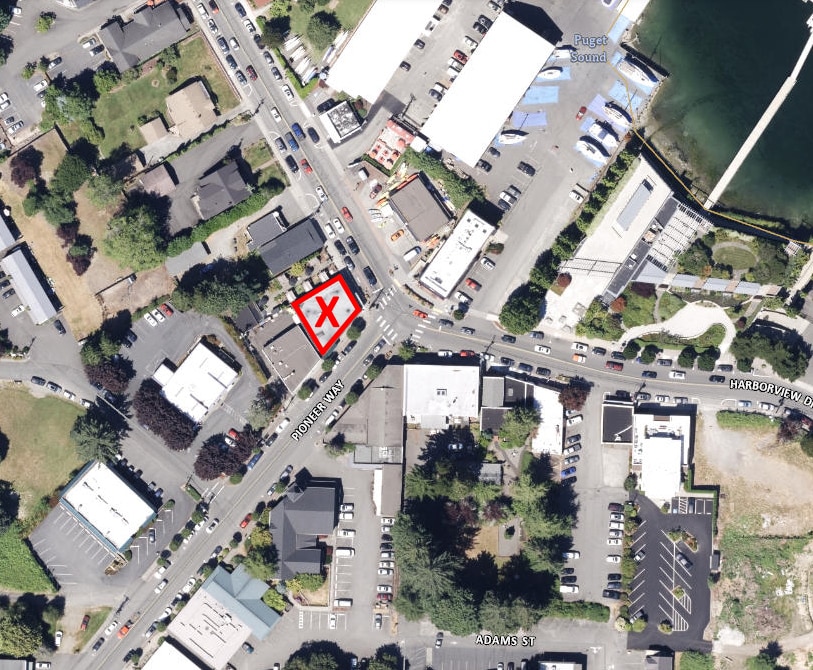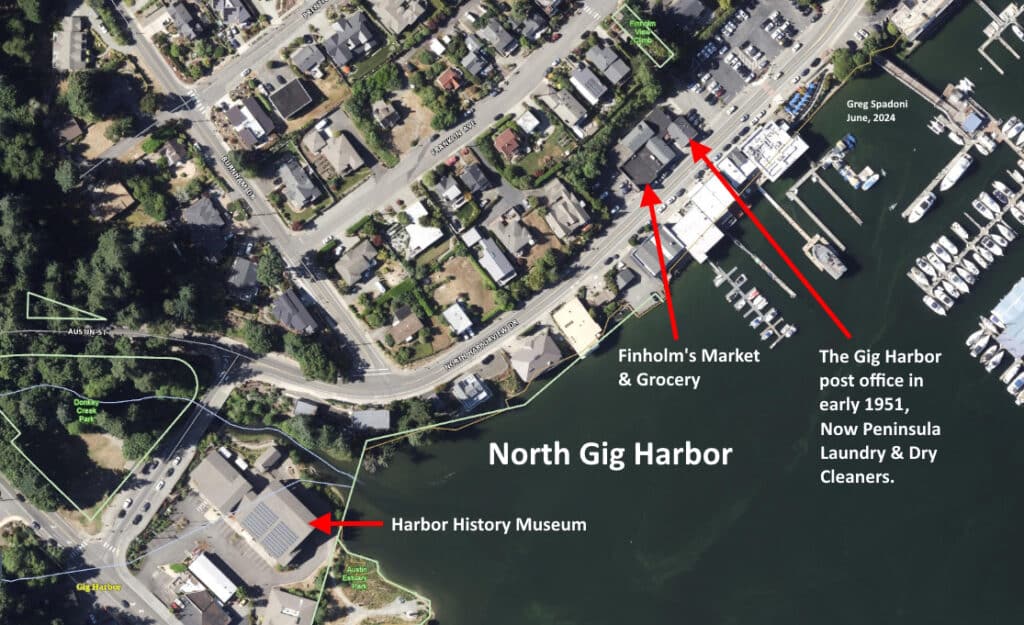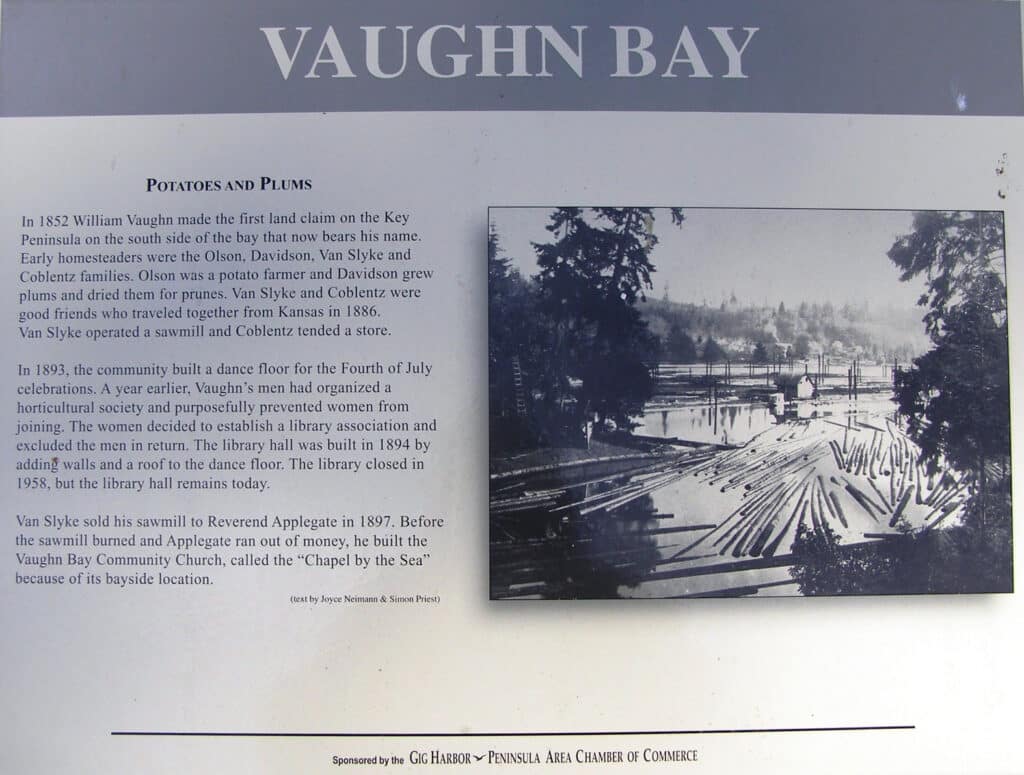Arts & Entertainment Community
Gig Harbor Now and Then | You may be familiar with this former Post Office location
Before we answer the previous local history question of the week, we’ll first do a little history business drawn from recent local news.
Community Sponsor
Community stories are made possible in part by Peninsula Light Co, a proud sponsor of Gig Harbor Now.
Charlee Glock-Jackson’s story, City sets out plan for txwaalqet Conservation Area, posted to Gig Harbor Now last Friday, led us to look a little deeper into the city of Gig Harbor’s plans for the new conservation area.
This page on the city’s website has a link to this one, also on the city’s website. Titled txʷaalqəł Conservation Area Phase I & II Property Management Plan, on page 3 (of 16) it gives the land use history of the new conservation area. For the benefit of historical accuracy, we’ll highlight a few short corrections:
Land Use History
The property was historically home to txʷaalqəł, a village of the sxʷəbabč band of the Puyallup Tribe. txʷaalqəł means “a place where game exists,” and was inhabited by the sxʷəbabč for many years without disturbance from European settlers. In 1840 [1841], Gig Harbor was “discovered” by members of the Wilkes Expedition. The first European settlers came in 1867 [1866 or somewhat earlier]. By 1915, the sxʷəbabč inhabitants were forced to relocate to the Puyallup Reservation in order to make room for European arrivals.
(There is documented evidence on file with Pierce County that the Gig Harbor Swiftwater People and the Puyallups living in Gig Harbor with them vacated the site in or before 1889 [although some likely remained in Gig Harbor at other locations]. As the legal, documented owners of the land in Gig Harbor at the mouth of Donkey Creek, having purchased it in 1874, they were not forced to relocate to the Puyallup Reservation or anywhere else to make room for European arrivals. The original General Land Office ledger shows that at least two families from Gig Harbor accepted land grants on the Puyallup Reservation in 1884, and that the number of acres between them was far in excess of what the Swiftwaters and Puyallups owned in Gig Harbor.)
The property was then used for logging. A large [small] mill was located at the mouth of North Creek, on what is now Austin Park.
The properties were part of the Burnham Homestead, claimed by Dr. Alfred Burnham in 1884. He filed the plat for the original town of Gig Harbor in 1888 [but not on his homestead claim]. The original old-growth timber was likely logged by Burnham and milled within the harbor [towed to mills outside of Gig Harbor (there were no sawmills in Gig Harbor when Burnham started logging the land)].
Immediately following that short history (on the next page), to illustrate the location of the Burnham homestead, the city’s document uses an outline drawn on an aerial map by one of Gig Harbor Now’s regular contributors. (That was news to me!)
Back to the question of the week
Our previous column, on loggers’ caulks, asked the question:
Where was the Gig Harbor Post Office in 1951?
Answer: Allan Undem knows where it was. That’s not surprising, considering that the Undem family’s time in Gig Harbor goes back to the 1930s.
At the risk of becoming repetitive, the answer is the same as the one given on Dec. 18 of last year, concerning the location of Berkheimer’s first Gig Harbor store.
It’s also the same as the answer given on Jan. 2 of this year, on the location of the original Safeway store in Gig Harbor: At the southwest corner of the intersection of Pioneer Way and Harborview Drive in Gig Harbor, in the very same building now occupied by Heritage Distilling.

In 1951 the Gig Harbor post office moved into the same building occupied today by the Heritage Distilling Co. Pierce County Assessor-Treasurer aerial base map.
However, the post office didn’t take up the entire building. It shared the space with one or more retail businesses. Whether it used the building entrance on Harborview Drive or the one on Pioneer Way wasn’t known to those of us too young to remember before Allan Undem revealed the answer just a few days ago. The entrance on Pioneer Way was the door to the post office.
In the second “however” in as many paragraphs, readers Ned Kirk, Mark Watland, and Ed Friedrich are also correct in saying that in 1951 the Gig Harbor post office was at the north end of Gig Harbor, in the building now occupied by Peninsula Laundry & Dry Cleaners. It had been there for over 20 years, but in mid-January 1951, was moved to the southwest corner of the intersection of Pioneer Way and Harborview Drive on the west side of the bay.

In January 1951, the Gig Harbor post office moved from the north end of the bay (at the location shown here) to the west side. Pierce County Assessor-Treasurer aerial base map.
While two weeks is a very small percentage of the whole of 1951, the fact remains that the post office was indeed at the north end of the bay during that year. And apparently not the entire post office operation left that year. According to the newspaper clip that reported the post office had moved, some post office boxes remained in the old location, for the convenience of people living nearby.
Fact-checking local history
For the second time in this week’s column, let’s take a look at a bit of recorded local history that doesn’t have it quite right. Instead of Gig Harbor, the historical marker in question this time is in Vaughn, right outside the Key Peninsula Historical Society Museum at the Civic Center. Concerning Vaughn, it says,
Potatoes and Plums
In 1852 William Vaughn made the first land claim on the Key Peninsula on the south side of the bay that now bears his name. Early homesteaders were the Olson, Davidson, Van Slyke and Coblentz families. Olson was a potato farmer and Davidson grew plums and dried them for prunes. Van Slyke and Coblentz were good friends who traveled together from Kansas in 1886. Van Slyke operated a sawmill and Coblentz tended a store.
In 1893, the community built a dance floor for the Fourth of July celebrations. A year earlier, Vaughn’s men had organized a horticultural society and purposefully prevented women from joining. The women decided to establish a library association and excluded the men in return. The library hall was built in 1894 by adding walls and a roof to the dance floor. The library closed in 1958, but the library hall remains today.
Van Slyke sold his sawmill to Reverend Applegate in 1897. Before the sawmill burned and Applegate ran out of money, he built the Vaughn Bay Community Church, called “Chapel by the Sea” because of its location.
On a simple read through, we noticed multiple errors. The first, that William Vaughn filed the first land claim on the Key Peninsula, is a whopper. Not only was Vaughn nowhere near the first to file a land claim on the Key Peninsula, but no land claims at all were filed there in 1852, or in any other year in the 1850s.
In 2022, Joseph Pentheroudakis documented that Vaughn didn’t file a claim on the Key Peninsula until the 1870s, long after many others had done so. And just last month in the Key Peninsula News, Joseph published a story on the earliest settlers of the area, noting that the first land claim filed on the Key Peninsula was in 1863.
The rest of the errors we noticed concern Reverend Applegate and his sawmill in Vaughn. There seems to be a shortage of evidence that he bought the Van Slyke sawmill, although he did buy some Van Slyke land. He finished building the Vaughn Bay Community Church before he bought a sawmill in Tacoma and had it moved to Vaughn. And that sawmill did not burn down. It went bankrupt from poor management.

This historical marker outside the Key Peninsula Historical Society Museum at the Key Peninsula Civic Center in Vaughn has multiple errors. Photo by Greg Spadoni.
Back to the woods
We return to the subject of logging this week because loggers are … interesting. (That’s a diplomatic word for this application.) Over a century ago, one logger from the Peninsula was so interesting, in fact, that one or more news wire services picked up a story about him. Papers in New York, Saskatchewan, Indiana, Missouri, Louisiana, Ohio, and Pennsylvania, among others, ran the story.
It took eight months for the story to cross the Pacific Ocean, where it was printed in the Albury Banner and Wodonga Express (which was one newspaper, not two) in New South Wales, Australia.
Now, in 2024, it comes back to Gig Harbor, not in print, but online.
What type of story has that kind of traction? In today’s world it would fit perfectly into the “oddities” category.
To the hunt
In 1907 the Day Logging Company was cutting timber in Rosedale, four miles west of Gig Harbor, with E. E. Marble operating its steam donkey log yarder. In a very common occurrence, Marble saw and seized an opportunity to engage in a bit of hunting while on the job. Quite often loggers would have rifles or shotguns with them in the woods for just such an occasion. But on this particular day Marble didn’t use a gun. There’s no indication that he had one with him. Instead, he employed some of the Day Logging Co. equipment in his hunt.
The prey was not what loggers normally hunted. In fact, it was not something loggers usually encountered in the woods. That’s why it made the news wires.
What was it?
It wasn’t an elephant … well, not a rogue elephant, anyway.
It wasn’t a Sasquatch. Any loggers finding one of those would’ve put it to work bucking logs or setting chokers.
Neither was it a space alien, although it was perhaps only somewhat more likely than a Martian.
Whatever it was, a case could easily be made for E. E. Marble having suffered temporary insanity at the time.
Today’s questions are:
What did E. E. Marble hunt in Rosedale while logging in 1907?
And:
What logging equipment did he use in the course of his hunt?
Disclaimer: Although Mr. Marble’s first name was Elmer, any similarity to Elmer Fudd is purely coincidental. Unlike Elmer Fudd, Elmer Marble actually caught his wascally whatever-it-was. But he didn’t use a shotgun to do it.

What in the world did Elmer E. Marble hunt in Rosedale in 1907 that was so interesting it was reported as far away as Australia?
We’ll have the answers on June 17. Included will be a dramatic illustration detailing the unprecedented hunt. That alone will be worth the price of admission.
We’ll also revisit the Key Peninsula to find out what that area could’ve been named, had “Key” not won the naming contest in 1931.
Greg Spadoni of Olalla has had more access to local history than most life-long residents. During 25 years in road construction working for the Spadoni Brothers, his first cousins, twice removed, he traveled to every corner of the Gig Harbor and Key Peninsulas, taking note of many abandoned buildings, overgrown farms, and roads that no longer had a destination. Through his current association with the Harbor History Museum in Gig Harbor as the unofficial Chief (and only) Assistant to Linda McCowen, the Museum’s primary photo archive volunteer, he regularly studies the area’s largest collection of visual history. Combined with the print history available at the Museum and online, he has uncovered countless stories of long-forgotten local people and events.

